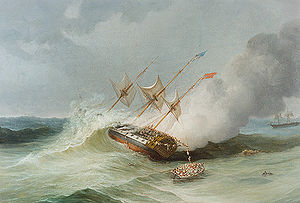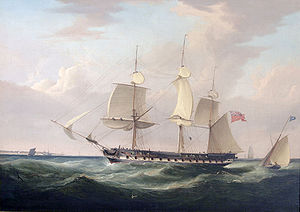Kent (East Indiaman)
| 50x40px | This article may need to be rewritten entirely to comply with Wikipedia's quality standards. You can help. The discussion page may contain suggestions. (May 2009) |
The Kent was an East Indiaman, that is, a vessel sailing for the British East India Company. She was a new ship of 1,350 tons, under Captain Henry Cobb, and on her maiden voyage, bound to Bengal and China. She left the Downs on 19 February 1825 with 20 officers, 344 soldiers, 43 women, and 66 children, belonging to the 31st regiment; with 20 private passengers, and a crew (including officers) of 148 men—in all, 641 persons on board.[1]
Loss
A report from 1832 states:
THE SHIP ON FIRE,
On the 1st of March 1825, the Kent East Indiaman took fire in the Bay of Biscay, She had sailed from the Downs about the middle of February, being bound to Bengal and China. By the roll of the vessel, a cask of spirits had been displaced; and, as the men were about to fix it in its former position, a heavy sea struck the ship, and precipitated a candle from the hands of one of them. This, falling on a small portion of the spirits, which had escaped from the cask, produced an instant conflagration, which defied every effort to stay its progress. At this awful crisis, the Cambria, Captain Cook, bound from London to Mexico, having on board thirty-five miners and superintendents of the Anglo-Mexican company, hove in sight. Seeing a signal of distress, Captain Cook instantly bore down; and, on approaching the Kent, discovered her to be on fire. Not a moment was lost in rendering every possible assistance, and transferring the crew and passengers to the brig. Throughout the whole of this affair, there appears to have been a very obvious display of providential superintendence. The Cambria could not, as we are informed, have fallen in with the Kent, had not Captain Cook been induced to lie to for the purpose of repairing the bulwarks of his vessel. It is also stated, that if the Cambria, on her return to Falmouth, had been detained by the wind a day or two longer, it must have occasioned deplorable discomfort on board his vessel, a brig of two hundred tons, with more than 600 souls crowded together in her cabin and on her deck. But for this timely interference, 547 lives must inevitably have been lost. [2]

Rescue
By chance the brigantine Cambria saw the Kent's distress signal. Cambria was a small vessel of some 200 tons, bound for Mexico with a crew of 11 men and some 20 Cornish miners. The crew and miners worked tirelessly to rescue survivors, fully cognizant of the risk that the Kent's magazine might explode at any time. There were instances of men who who tied the children of brother soldiers on their backs, and leaping overboard swam with their burdens to the boats. By the following evening, the Cambria had some 550 survivors aboard her.
The crew of the ill-fated Kent unfortunately did not behave as well as the miners or soldiers. They refused to return for their shipmates after the first trip until the captain of the '"Cumbria threatened not to let them board unless they did so.
At 2 am in the morning the Kent did blow up. Two hours after the ship blew up, a soldier's wife was delivered on board the Cambria. Still, Cambria was able to land the survivors back in Falmouth three days later. Fourteen of the men who remained on the wreck were rescued the following morning by the Caroline and carried to Liverpool. The miners and others associated with the rescue received silver medals in recognition of their courageous efforts.
Casualty list
A total of 81 lives were lost[3]
- 54 soldiers belonging to the 31st Regiment of Foot
- 1 woman
- 20 children
- 1 seaman
- 5 boys
The Kent in art
The loss of the Kent was highly newsworthy and led a number of artists to paint their own versions of the tragedy. In addition to William Daniell, artists that dealt with the tragedy included Théodore Gudin, Thomas Marie Madawaska Hemy (1874-1931), and an anonymous lithographer whose "Loss of the Kent" is in the National Maritime Museum, as are a number of other renditions. (The National Maritime Museum Cornwall also has an acquatint of Daniell's painting.)
References
- ↑ The Loss of the Kent, East Indiaman, in the Bay of Biscay, by Duncan McGregor Project Gutenberg EBook
- ↑ The record of Providence; or, The government of God displayed in a series of ... By John Young (1832)
- ↑ The Loss of the Kent, East Indiaman, in the Bay of Biscay, by Duncan McGregor Project Gutenberg EBook
| 40px | This article about a specific civilian ship or boat is a stub. You can help Ship Spotting World by expanding it. |
- Pages with broken file links
- Wikipedia articles needing rewrite from May 2009
- Articles with invalid date parameter in template
- Unclassified articles missing geocoordinate data
- All articles needing coordinates
- 1825 in the United Kingdom
- Maritime incidents in 1825
- Passenger ships of the United Kingdom
- Shipwrecks in the Atlantic Ocean
- Ships of the British East India Company
- Individual ship or boat stubs

